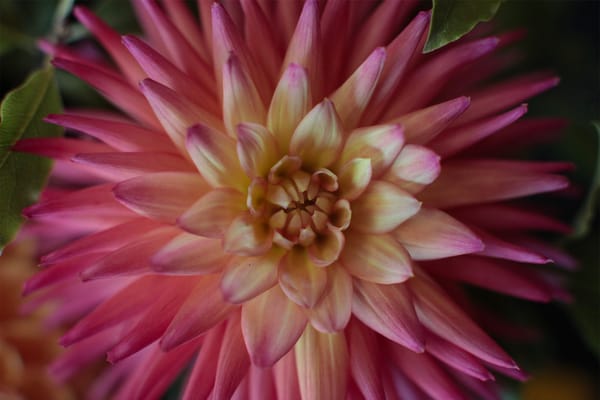In a world of shifting seasons and unpredictable weather, how we grow our gardens matters more than ever. Dahlias — those icons of late-summer splendour — might seem extravagant in a low-impact garden, but with thoughtful choices, they can thrive within sustainable, climate-conscious practices.
Today’s ethical gardener isn’t just planting for beauty. They’re cultivating with respect for water, soil, pollinators, and the living systems that sustain us all. Here’s how to grow dahlias responsibly — and why each choice makes a difference.
Water Wisely: Growing Resilient Dahlias in a Warming Climate
As summers grow hotter and drier, water stewardship is one of the most pressing concerns for ethical gardeners. Dahlias, with their thirst for moisture, may seem a challenge — but with the right methods, they can flourish while conserving precious water.
- Choose Resilient Varieties
Single-flowered dahlias like Bishop of Llandaff or Mystic Illusion are naturally hardier in dry spells. Their open centers not only make them pollinator magnets but tend to produce stronger, deeper roots, better equipped for drought. - Deep, Infrequent Watering
A deep soak encourages roots to grow downward in search of moisture, rather than clustering at the surface. This builds a stronger, more self-sufficient plant and reduces your watering frequency over time — a win for both plant health and water conservation. - Mulch as a Water Saver
A thick layer of organic mulch (4–8 inches) acts like a natural sponge, locking moisture in the soil and keeping roots cool. In dry climates or hot summers, this can halve the amount of water your garden needs — and it suppresses weeds too. - Improve Your Soil’s Sponge
Sandy or light soils often struggle to hold water. Mixing in leaf mold, home compost, or coconut coir boosts their water-holding capacity, building a living soil that supports your plants naturally through dry spells.
No-Dig, No-Till: How to Grow Without Disrupting the Soil
Digging might feel like the traditional start to a flower bed — but it can do more harm than good. Tilling breaks up delicate soil structures, releases stored carbon, and disrupts the underground world of microbes, fungi, and earthworms that help plants thrive.
- Why No-Dig Works
Laying compost or mulch on top of undisturbed soil feeds the ecosystem below. Worms and soil organisms naturally incorporate nutrients, improving aeration and structure without manual effort. - Surface Planting Success
By planting straight into compost-rich layers, you encourage healthier root systems and reduce the risk of soil erosion — while also keeping watering needs low. - Permanent Mulch, Permanent Benefits
Keeping soil covered with mulch or low-growing ground cover protects it year-round, reducing carbon loss and fostering biodiversity underground. It also keeps your beds looking lush and well-tended through every season.
Why Peat-Free Matters
Peat might seem harmless in a bag of compost, but its extraction destroys carbon-rich wetlands — some of the planet’s most vital carbon sinks — and releases greenhouse gases.
- Ethical Alternatives
Look for composts made from bark, green waste, coir, or wool. Even better, make your own compost from garden and kitchen scraps. This keeps nutrients cycling locally and cuts the environmental cost of commercial production and transport.
Pollinator-Friendly Dahlia Growing: Beauty with a Purpose
Dahlias aren’t just for show — they can be vital feeding stations for bees, hoverflies, and butterflies, especially late in the season when other nectar sources fade. But not all dahlias are equal in this regard.
- Choose Open-Centered Varieties
Single, collarette, and anemone-flowered dahlias reveal their pollen and nectar. These are lifelines for pollinators — especially in Cornwall’s mild autumns, when other blooms decline. - Skip the Sprays
Chemical pesticides can devastate beneficial insect populations. Instead, encourage natural predators like ladybirds or use gentle, targeted organic methods only when truly necessary. - Plant for Diversity
A mixed border of dahlias with long-flowering perennials (like salvias or cosmos) creates a continuous feast for pollinators — and a dynamic, ever-changing garden tapestry for you.
Sustainable Growing at a Glance
| Practice | Environmental Benefit | Dahlia Health Benefit |
|---|
| Low-water & mulching | Conserve water, reduce runoff | Resilient growth, deeper roots |
| No-dig/no-till beds | Protect soil life, store carbon | Healthier roots, reduced weeds |
| Peat-free growing | Prevent habitat loss, reduce carbon emissions | Strong, healthy tubers |
| Pollinator-friendly varieties | Support biodiversity | Better seed set, stronger plants |
| Homemade compost | Reduce waste, build healthy soil | Balanced nutrition, vigorous growth |
Growing with a Conscience: Your Garden, Your Climate Impact
Your dahlia border can be more than a riot of color — it can be a small but powerful act of climate care. From harvesting rainwater to swapping tubers with local gardeners, every mindful choice builds a healthier, more resilient garden ecosystem.
- Rotate crops to protect soil health
- Use rain barrels or greywater for irrigation
- Save and share your own seed or tubers to reduce transport miles
- Join or start a community composting group to close the loop on garden waste
Final Thoughts: A Garden That Gives Back
Ethical dahlia growing isn’t about compromise — it’s about growing with heart and understanding. By embracing low-water techniques, nurturing the living soil, protecting pollinators, and rejecting peat, you’ll craft a garden that bursts with color while quietly doing good.
In a changing climate, this kind of beauty matters more than ever. It’s gardening that respects nature’s rhythms — and it’s a practice we believe will define the future of Cornish horticulture.











